Exploiting Plasma Exposed, Natural Surface Nanostructures in Ramie Fibers for Polymer Composite Applications
Abstract
1. Introduction
2. Experimental Work
2.1. Materials
2.2. Low Pressure Plasma-Surface Treatment
2.3. Surface and Cross-Section Observations of Ramie Fibers
2.4. Attenuated Total Reflectance-Fourier Transform Infrared Spectroscopy (ATR-FTIR)
2.5. Wettability Measurements
2.6. Tensile Test of Single Ramie Fibers
- Before testing the fiber, images at different locations along the fiber gauge length were taken using an optical microscope (Nikon Eclipse LV150, Tokyo, Japan). The cross-section of each single fiber was assumed to be circular. The fiber diameter was directly measured from the images and hence the cross-sectional area of each single fiber was calculated from the average of three apparent fiber diameter measurements (30 samples for each treatment time).
- As the single fiber failure is elastic without any signs of plastic deformation, it can be assumed that the cross-sectional area of the fractured fibers has not changed significantly after the test. Therefore, after testing, LV-SEM was used to observe the cross-section area of the fractured fibers. Fractured fibers with a flat and clear cross-section end (Figure 2a) were selected for the cross-section area calculations whereas fractured fibers that split into fibrils (Figure 2b) were not included in the results as accurate area measurements were not possible for these samples. Thereafter, the collected LV-SEM images were used to calculate the actual cross-sectional area of the fractured fibers by using image J software. The hollow structure (lumen) can be clearly seen in Figure 2a, excluded from the total area. The sample size for each treatment time varied depending on fracture surface end (Table S1 in the Supplementary Materials).
3. Results and Discussion
3.1. Microstructure of Single Ramie Fiber
3.2. Surface Morphology Analysis
3.3. Surface Chemical Structure Analysis
3.4. Surface Wettability of Fibers
3.5. Single Fiber Mechanical Properties
4. Conclusions
Supplementary Materials
Author Contributions
Funding
Acknowledgments
Conflicts of Interest
References
- Poriķe, E.; Andersons, J. Strength-length scaling of elementary hemp fibers. Mech. Compos. Mater. 2013, 49, 69–76. [Google Scholar] [CrossRef]
- Thomas, S.; Paul, S.A.; Pothan, L.A.; Deepa, B. Natural Fibres: Structure, Properties and Applications. In Cellulose Fibers: Bio- and Nano-Polymer Composites; Springer Nature: Basingstoke, UK, 2011; pp. 3–42. [Google Scholar]
- Pickering, K.; Efendy, M.A.; Le, T. A review of recent developments in natural fibre composites and their mechanical performance. Compos. Part A Appl. Sci. Manuf. 2016, 83, 98–112. [Google Scholar] [CrossRef]
- Elanchezhian, C.; Ramnath, B.; Ramakrishnan, G.; Rajendrakumar, M.; Naveenkumar, V.; Saravanakumar, M. Review on mechanical properties of natural fiber composites. Mater. Today Proc. 2018, 5, 1785–1790. [Google Scholar] [CrossRef]
- Oksman, K.; Mathew, A.P.; Långström, R.; Nyström, B.; Joseph, K. The influence of fibre microstructure on fibre breakage and mechanical properties of natural fibre reinforced polypropylene. Compos. Sci. Technol. 2009, 69, 1847–1853. [Google Scholar] [CrossRef]
- Matoke, G.M.; Owido, S.F.; Nyaanga, D.M. Effect of Production Methods and Material Ratios on Physical Properties of the Composites. Am. Int. J. Contemp. Res. 2012, 2, 208–213. [Google Scholar]
- Liu, X.; Cheng, L. Influence of Plasma Treatment on Properties of Ramie Fiber and the Reinforced Composites. J. Text. Inst. 2017, 31, 1723–1734. [Google Scholar] [CrossRef]
- Zhang, Q.; Jiang, Y.; Yao, L.; Jiang, Q.; Qiu, Y. Hydrophobic surface modification of ramie fibers by plasma-induced addition polymerization of propylene. J. Adhes. Sci. Technol. 2015, 29, 691–704. [Google Scholar] [CrossRef]
- Xu, C.; Gu, Y.; Yang, Z.; Li, M.; Li, Y.; Zhang, Z. Mechanical Properties of Surface-Treated Ramie Fiber Fabric/Epoxy Resin Composite Fabricated by Vacuum-Assisted Resin Infusion Molding with Hot Compaction. J. Compos. Mater. 2016, 50, 1189–1198. [Google Scholar] [CrossRef]
- Koronis, G.; Silva, A.; Dias, A.P.S.; Dias, A.P.S. Development of green composites reinforced with ramie fabrics: Effect of aging on mechanical properties of coated and uncoated specimens. Fibers Polym. 2014, 15, 2618–2624. [Google Scholar] [CrossRef]
- Pandey, S.N. Ramie Fibre: Part II. Physical Fibre Properties. A Critical Appreciation of Recent Developments. Text. Prog. 2007, 39, 189–268. [Google Scholar] [CrossRef]
- Thomas, L.H.; Forsyth, V.T.; Sturcova, A.; Kennedy, C.J.; May, R.P.; Altaner, C.M.; Apperley, D.C.; Wess, T.J.; Jarvis, M.C. Structure of Cellulose Microfibrils in Primary Cell Walls from Collenchyma. Plant Physiol. 2013, 161, 465–476. [Google Scholar] [CrossRef]
- Nishiyama, Y.; Kim, U.-J.; Kim, D.-Y.; Katsumata, K.S.; May, R.P.; Langan, P. Periodic Disorder along Ramie Cellulose Microfibrils. Biomacromolecules 2003, 4, 1013–1017. [Google Scholar] [CrossRef] [PubMed]
- Sinha, E.; Rout, S.K. Influence of fibre-surface treatment on structural, thermal and mechanical properties of jute fibre and its composite. Mater. Sci. 2009, 32, 65–76. [Google Scholar] [CrossRef]
- Choi, H.Y.; Lee, J.S. Effects of surface treatment of ramie fibers in a ramie/poly(lactic acid) composite. Fibers Polym. 2012, 13, 217–223. [Google Scholar] [CrossRef]
- Zhou, Z.; Liu, X.; Hu, B.; Wang, J.; Xin, D.; Wang, Z.; Qiu, Y. Hydrophobic surface modification of ramie fibers with ethanol pretreatment and atmospheric pressure plasma treatment. Surf. Coatings Technol. 2011, 205, 4205–4210. [Google Scholar] [CrossRef]
- Pietak, A.; Korte, S.; Tan, E.; Downard, A.; Staiger, M.P.; Korte-Kerzel, S. Atomic force microscopy characterization of the surface wettability of natural fibres. Appl. Surf. Sci. 2007, 253, 3627–3635. [Google Scholar] [CrossRef]
- Jelil, R.A. A review of low-temperature plasma treatment of textile materials. J. Mater. Sci. 2015, 50, 5913–5943. [Google Scholar] [CrossRef]
- Yaman, N.; Özdoğan, E.; Seventekin, N.; Ayhan, H. Plasma treatment of polypropylene fabric for improved dyeability with soluble textile dyestuff. Appl. Surf. Sci. 2009, 255, 6764–6770. [Google Scholar] [CrossRef]
- Kan, C.; Chan, K.; Yuen, C.; Miao, M. Surface properties of low-temperature plasma treated wool fabrics. J. Mater. Process. Technol. 1998, 83, 180–184. [Google Scholar] [CrossRef]
- Bozaci, E.; Sever, K.; Sarikanat, M.; Seki, Y.; Demir, A.; Özdoğan, E.; Tavman, I. Effects of the atmospheric plasma treatments on surface and mechanical properties of flax fiber and adhesion between fiber–matrix for composite materials. Compos. Part B Eng. 2013, 45, 565–572. [Google Scholar] [CrossRef]
- Prakash, N.H.; Sarma, B.; Gopi, S.; Sarma, A. Surface and Moisture Characteristics of Jute Using a D.C. Glow Discharge Argon Plasma. Instrum. Sci. Technol. 2016, 44, 73–84. [Google Scholar] [CrossRef]
- Sinha, E.; Panigrahi, S. Effect of Plasma Treatment on Structure, Wettability of Jute Fiber and Flexural Strength of its Composite. J. Compos. Mater. 2009, 43, 1791–1802. [Google Scholar] [CrossRef]
- Barani, H.; Calvimontes, A. Effects of Oxygen Plasma Treatment on the Physical and Chemical Properties of Wool Fiber Surface. Plasma Chem. Plasma Process. 2014, 34, 1291–1302. [Google Scholar] [CrossRef]
- Parida, D.; Jassal, M.; Agarwal, A.K. Functionalization of Cotton by In-Situ Reaction of Styrene in Atmospheric Pressure Plasma Zone. Plasma Chem. Plasma Process. 2012, 32, 1259–1274. [Google Scholar] [CrossRef]
- Vesel, A.; Mozetic, M.; Strnad, S.; Peršin, Z.; Stana-Kleinschek, K.; Hauptman, N. Plasma modification of viscose textile. Vacuum 2009, 84, 79–82. [Google Scholar] [CrossRef]
- Samanta, K.K.; Gayatri, T.N.; Shaikh, A.H.; Saxena, S.; Arputharaj, A.; Basak, S.; Chattopadhyay, S.K. Effect of Helium-Oxygen Plasma Treatment on Physical and Chemical Properties of Cotton Textile. Int. J. Bioresour. Sci. 2014, 1, 57–63. [Google Scholar]
- Samanta, K.K.; Joshi, A.G.; Jassal, M.; Agrawal, A.K. Study of hydrophobic finishing of cellulosic substrate using He/1,3-butadiene plasma at atmospheric pressure. Surf. Coatings Technol. 2012, 213, 65–76. [Google Scholar] [CrossRef]
- Balu, B.; Breedveld, V.; Hess, D.W. Fabrication of “Roll-off” and “Sticky” Superhydrophobic Cellulose Surfaces via Plasma Processing. Langmuir 2008, 24, 4785–4790. [Google Scholar] [CrossRef]
- Jiang, L.; Park-Lee, K.J.; Clinton, R.M.; Tang, Z.; Breedveld, V.; Hess, D.W. Mechanical durability of liquid repellent coatings. Surf. Coatings Technol. 2017, 328, 182–191. [Google Scholar] [CrossRef]
- Oelichmann, J. Surface and depth-profile analysis using FTIR spectroscopy. Anal. Bioanal. Chem. 1989, 333, 353–359. [Google Scholar] [CrossRef]
- Asim, M.; Saba, N.; Jawaid, M.; Nasir, M.; Pervaiz, M.; Alothman, O.Y. A Review on Phenolic Resin and Its Composites. Curr. Anal. Chem. 2018, 14, 1–13. [Google Scholar] [CrossRef]
- Rebouillat, S.; Letellier, B.; Steffenino, B. Wettability of single fibres – beyond the contact angle approach. Int. J. Adhes. Adhes. 1999, 19, 303–314. [Google Scholar] [CrossRef]
- Everitt, N.M.; Aboulkhair, N.T.; Clifford, M.J. Looking for Links between Natural Fibres’ Structures and Their Physical Properties. Conf. Pap. Mater. Sci. 2013, 2013, 1–10. [Google Scholar] [CrossRef]
- Kicińska-Jakubowska, A.; Bogacz, E.; Zimniewska, M. Review of Natural Fibers. Part I-Vegetable Fibers. J. Nat. Fibers 2012, 9, 150–167. [Google Scholar] [CrossRef]
- Meier, H. Chemical and morphological aspects of the fine structure of wood. Pure Appl. Chem. 1962, 5, 37–52. [Google Scholar] [CrossRef]
- Szymanski, D.B.; Cosgrove, D.J. Dynamic Coordination of Cytoskeletal and Cell Wall Systems during Plant Cell Morphogenesis. Curr. Boil. 2009, 19, R800–R811. [Google Scholar] [CrossRef]
- Han, S.O.; Choi, H.Y. Morphology and Surface Properties of Natural Fiber Treated with Electron Beam. Microsc. Sci. Technol. Appl. Educ. 2010, 1880, 1880–1887. [Google Scholar]
- Wohlfart, E.; Fernández-Blázquez, J.P.; Knoche, E.; Bello, A.; Pérez, E.; Arzt, E.; Del Campo, A. Nanofibrillar Patterns by Plasma Etching: The Influence of Polymer Crystallinity and Orientation in Surface Morphology. Macromolecules 2010, 43, 9908–9917. [Google Scholar] [CrossRef]
- Stehling, N.; Masters, R.; Zhou, Y.; O’Connell, R.; Holland, C.; Zhang, H.; Rodenburg, C. New perspectives on nano-engineering by secondary electron spectroscopy in the helium ion and scanning electron microscope. MRS Commun. 2018, 8, 226–240. [Google Scholar] [CrossRef]
- Hamad, S.F.; Stehling, N.; Holland, C.; Foreman, J.; Rodenburg, C. Low-Voltage SEM of Natural Plant Fibers: Microstructure Properties (Surface and Cross-Section) and their Link to the Tensile Properties. Procedia Eng. 2017, 200, 295–302. [Google Scholar] [CrossRef]
- Chinga-Carrasco, G. Cellulose fibres, nanofibrils and microfibrils: The morphological sequence of MFC components from a plant physiology and fibre technology point of view. Nanoscale Lett. 2011, 6, 417. [Google Scholar] [CrossRef]
- Romanzini, D.; Júnior, H.L.O.; Amico, S.C.; Zattera, A.J. Preparation and characterization of ramie-glass fiber reinforced polymer matrix hybrid composites. Mater. Res. 2012, 15, 415–420. [Google Scholar] [CrossRef]
- Morshed, M.M.; Alam, M.M.; Daniels, S. Plasma Treatment of Natural Jute Fibre by RIE 80 plus Plasma Tool. Plasma Sci. Technol. 2010, 12, 325–329. [Google Scholar] [CrossRef]
- Sinha, E. Effect of Cold Plasma Treatment on Macromolecular Structure, Thermal and Mechanical Behavior of Jute Fiber. J. Ind. Text. 2009, 38, 317–339. [Google Scholar] [CrossRef]
- Brígida, A.; Calado, V.; Gonçalves, L.; Coelho, M.; Coelho, M.A.Z. Effect of chemical treatments on properties of green coconut fiber. Carbohydr. Polym. 2010, 79, 832–838. [Google Scholar] [CrossRef]
- Hnilica, J.; Potocnakova, L.; Stupavska, M.; Kudrle, V. Rapid surface treatment of polyamide 12 by microwave plasma jet. Appl. Surf. Sci. 2014, 288, 251–257. [Google Scholar] [CrossRef]
- Herrera-Franco, P.; Valadez-Gonzalez, A. A study of the mechanical properties of short natural-fiber reinforced composites. Compos. Part B: Eng. 2005, 36, 597–608. [Google Scholar] [CrossRef]
- Vogler, E.A. Structure and reactivity of water at biomaterial surfaces. Adv. Colloid Interface Sci. 1998, 74, 69–117. [Google Scholar] [CrossRef]
- Levón, J. Microbial Adhesion on Biomaterials and the Sources of Human Beta-Defensin-3 in Septic Joint Implant Loosening. Ph.D. Thesis, University of Helsinki, Helsinki, Finland, 2017. [Google Scholar]
- Silva, F.D.A.; Chawla, N.; Filho, R.D.D.T. Tensile behavior of high performance natural (sisal) fibers. Compos. Sci. Technol. 2008, 68, 3438–3443. [Google Scholar] [CrossRef]

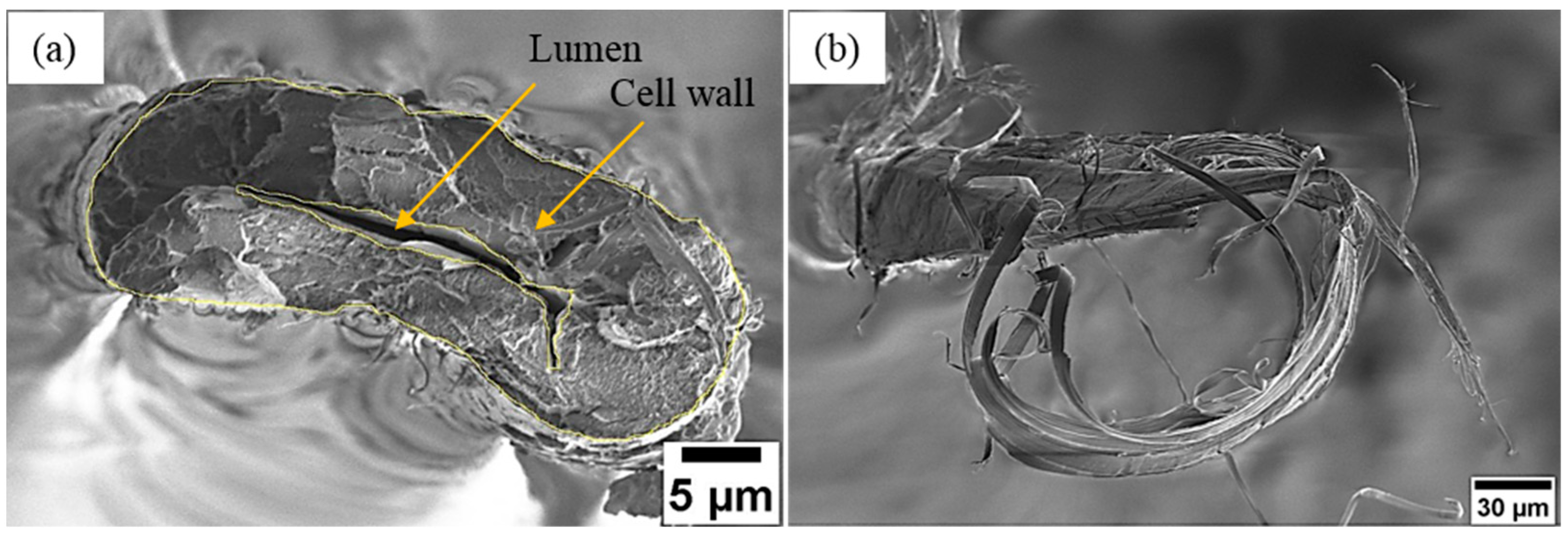

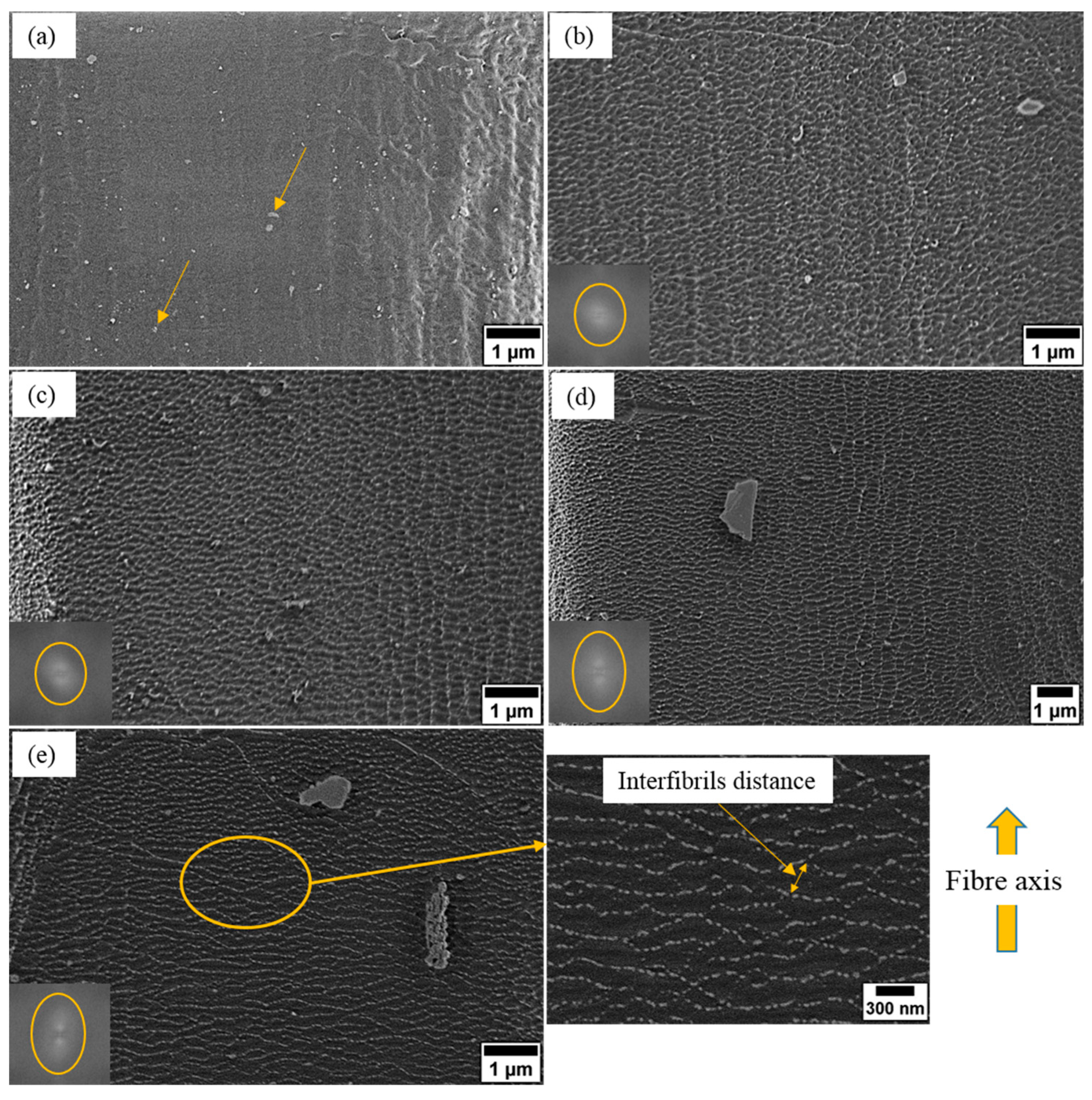
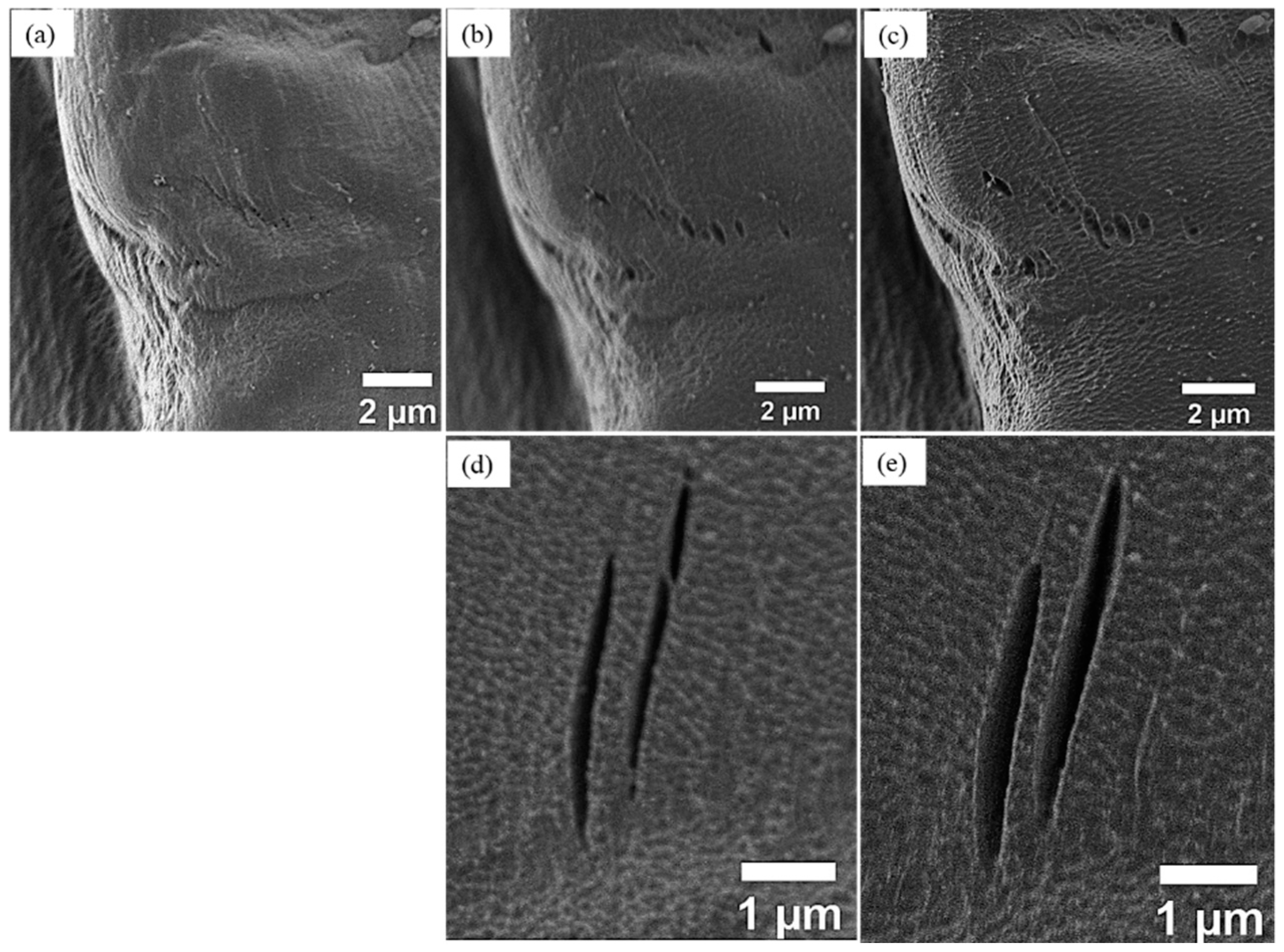
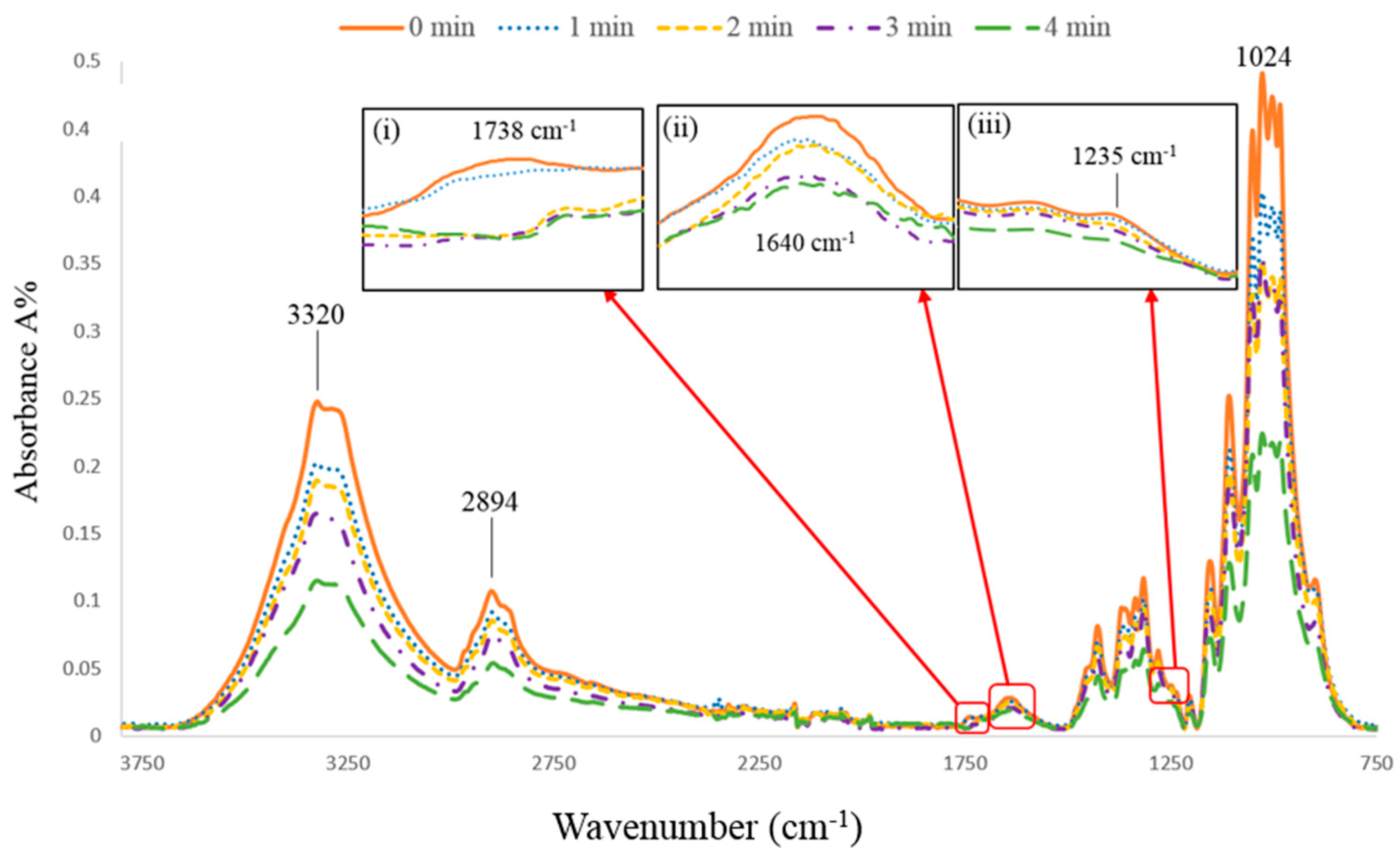
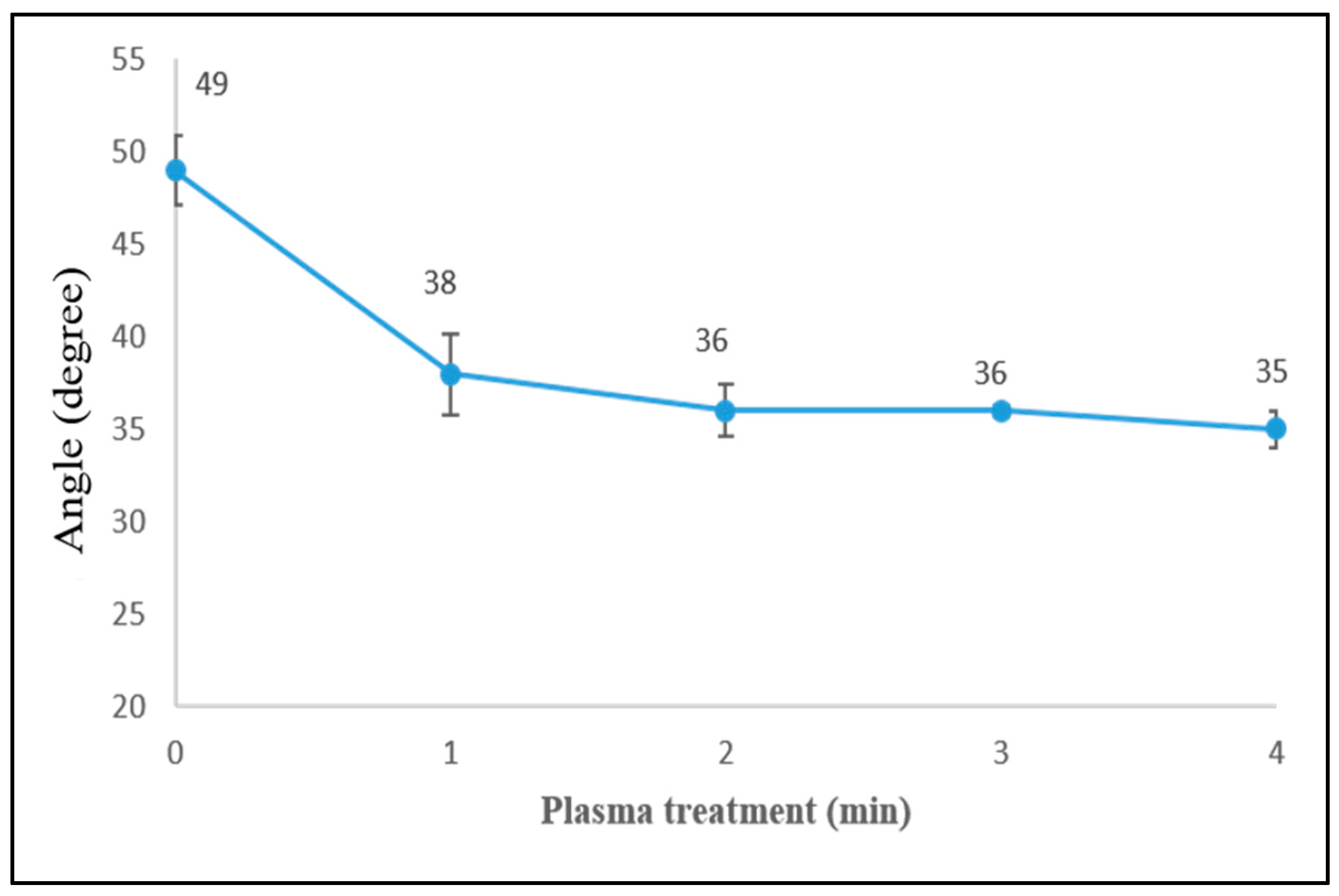
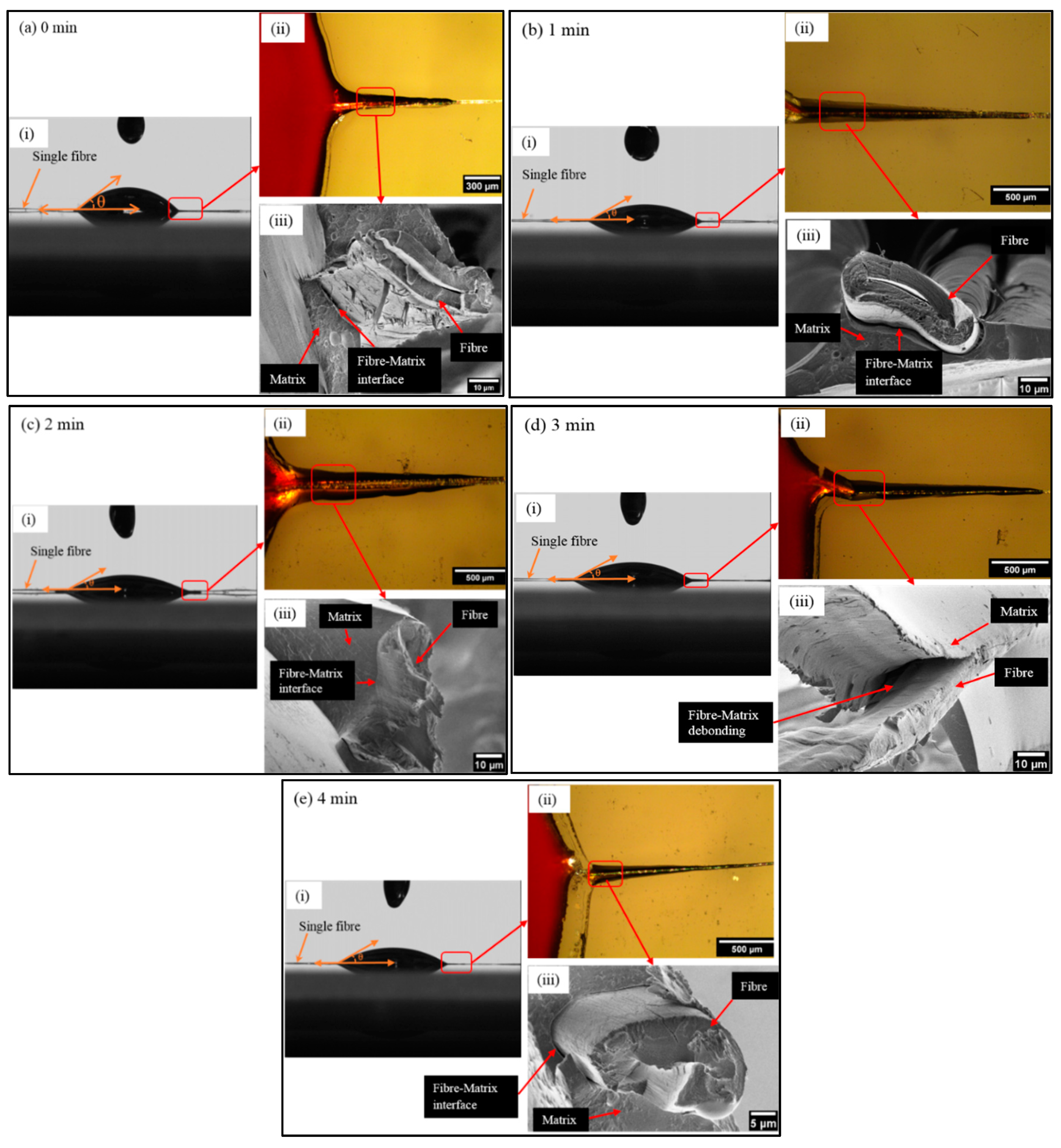
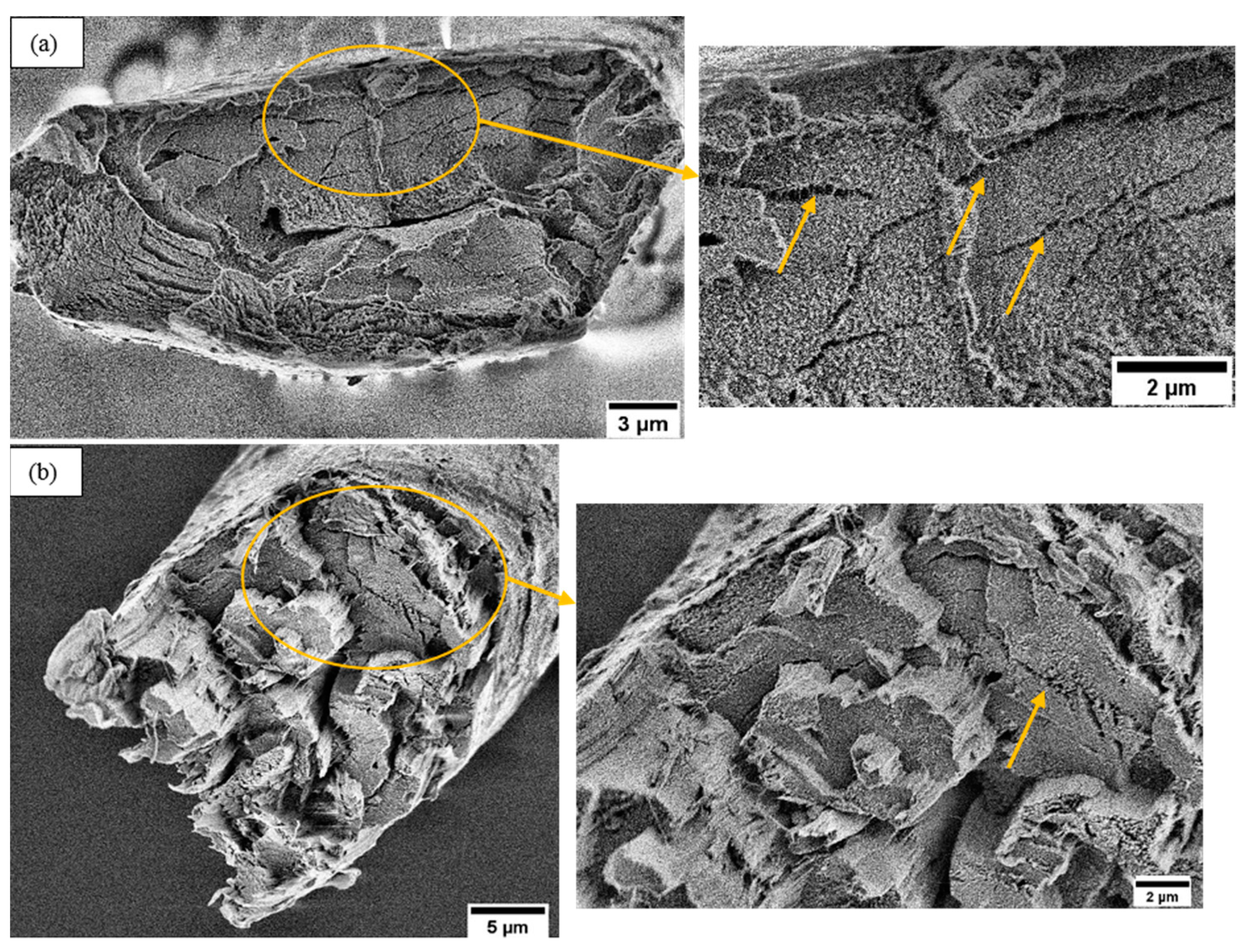
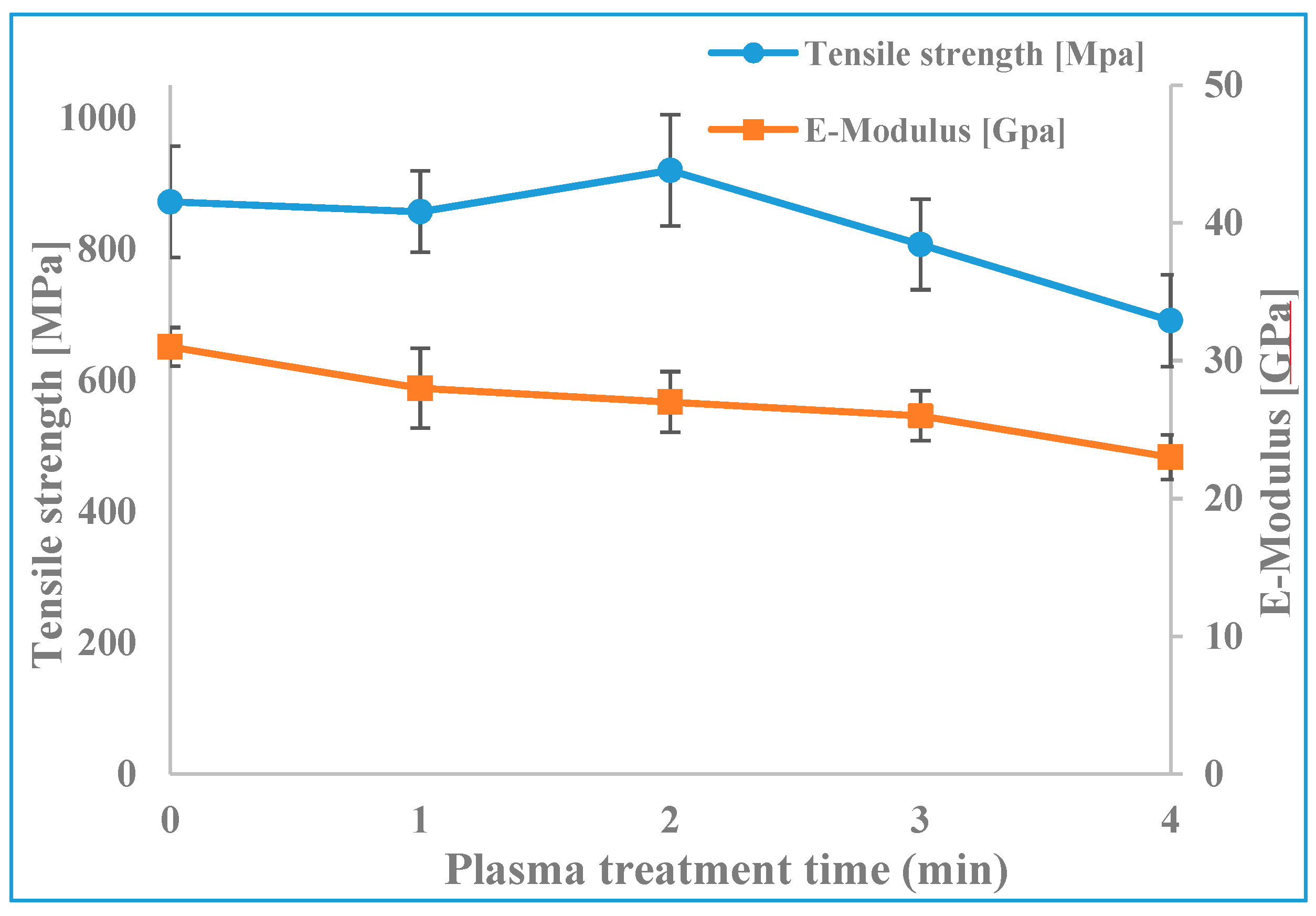
| Structural Bond | Associated Components | Standard Peak Position (cm−1) | Measured Peak Position (cm−1) | Effect of Plasma Treatment |
|---|---|---|---|---|
| OH stretching | Cellulose | 3200 ̴ 3600 | ̴ 3320 | Started to decrease after 3 min |
| CH2 stretching | Cellulose and hemicellulose | ̴ 2925 | 2894 | None |
| C=O stretching | Cellulose and hemicellulose | 1725 ̴ 1750 | 1738 | Decreased after 2 min |
| H–O–H bending | Absorbed water | ̴ 1650 | 1640 | Decreased gradually with treatment time |
| CH2 deformation | Lignin | 1435 ̴ 1480 | 1423 | None |
| CH3 bending | Lignin | 1340 ̴ 1390 | 1354 | None |
| CH2 wagging | Lignin | ̴ 1320 | 1316 | None |
| C–O stretching | Waxes | 1275 ̴ 1185 | 1235 | Decreased gradually with treatment |
| C–O stretching | Cellulose | 1160 ̴ 1000 | 1094 | None |
| O–H deformation | Cellulose | 1080 ̴ 1030 | 1024 | Started to decrease after 3 min |
| β-Glucosidic linkage | Hemicellulose | ̴ 885 | 898 | None |
© 2019 by the authors. Licensee MDPI, Basel, Switzerland. This article is an open access article distributed under the terms and conditions of the Creative Commons Attribution (CC BY) license (http://creativecommons.org/licenses/by/4.0/).
Share and Cite
Hamad, S.F.; Stehling, N.; Hayes, S.A.; Foreman, J.P.; Rodenburg, C. Exploiting Plasma Exposed, Natural Surface Nanostructures in Ramie Fibers for Polymer Composite Applications. Materials 2019, 12, 1631. https://doi.org/10.3390/ma12101631
Hamad SF, Stehling N, Hayes SA, Foreman JP, Rodenburg C. Exploiting Plasma Exposed, Natural Surface Nanostructures in Ramie Fibers for Polymer Composite Applications. Materials. 2019; 12(10):1631. https://doi.org/10.3390/ma12101631
Chicago/Turabian StyleHamad, Sameer F., Nicola Stehling, Simon A. Hayes, Joel P. Foreman, and C. Rodenburg. 2019. "Exploiting Plasma Exposed, Natural Surface Nanostructures in Ramie Fibers for Polymer Composite Applications" Materials 12, no. 10: 1631. https://doi.org/10.3390/ma12101631
APA StyleHamad, S. F., Stehling, N., Hayes, S. A., Foreman, J. P., & Rodenburg, C. (2019). Exploiting Plasma Exposed, Natural Surface Nanostructures in Ramie Fibers for Polymer Composite Applications. Materials, 12(10), 1631. https://doi.org/10.3390/ma12101631





